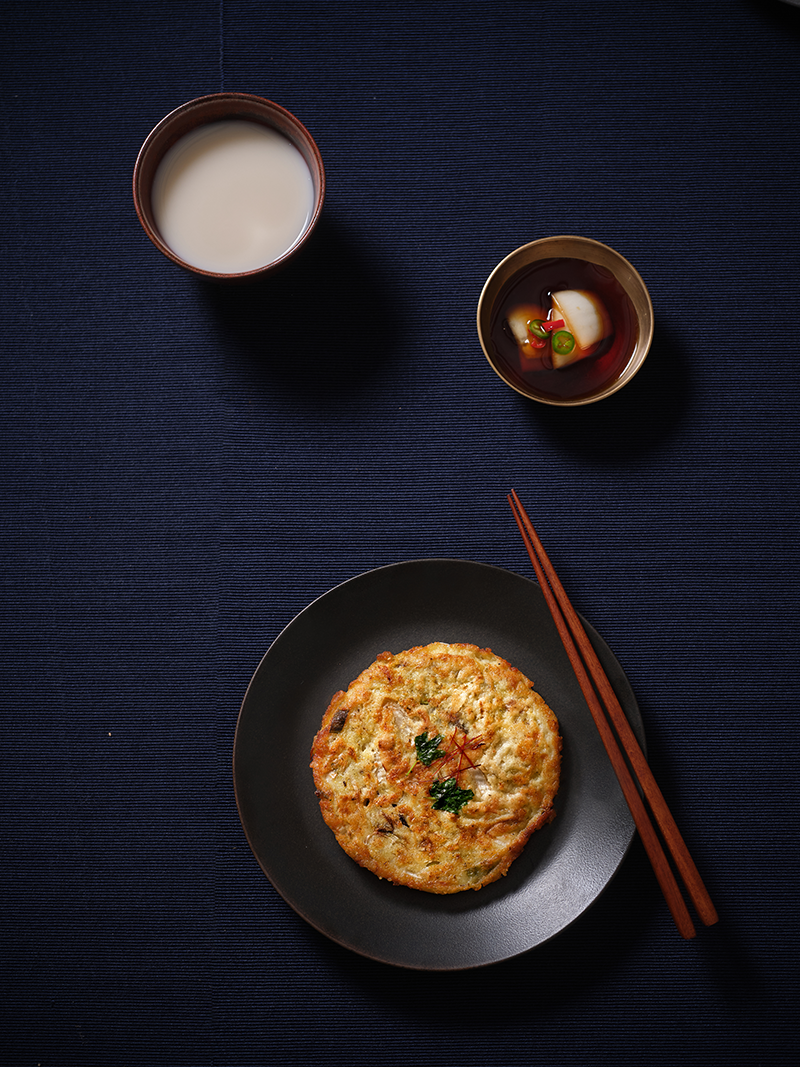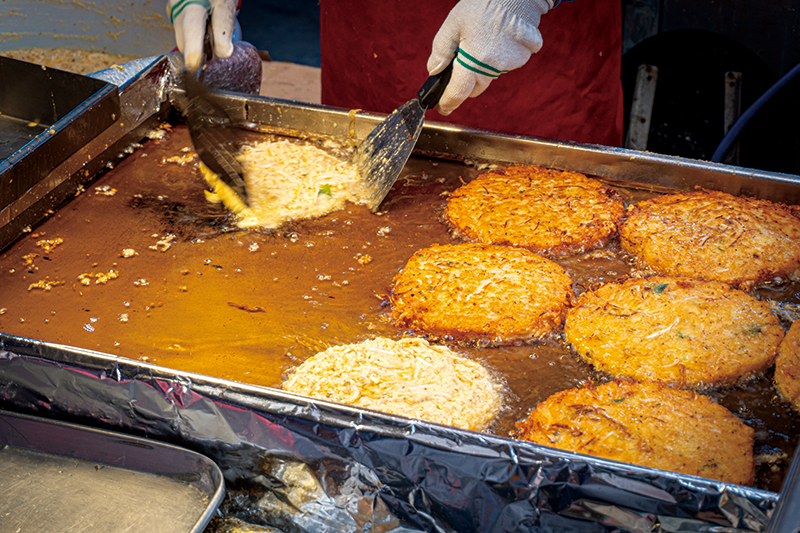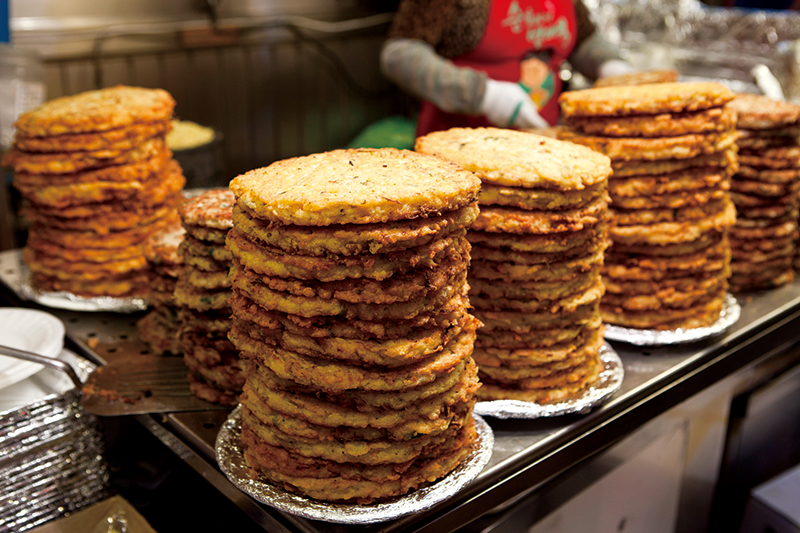Made by frying a thick batter consisting of mung bean flour, meat, and assorted vegetables until it attains an attractively golden-brown color, bindaetteok is a traditional Korean dish notable for its distinctive crispy texture and nutty taste.

Made with ground mung beans instead of wheat flour like most buchimgae dishes, bindaetteok is the very definition of “geot-ba-sok-chok,” a Korean term used to describe foods which are crisp on the outside and moist on the inside.
Koreans use the term “geot-ba-sok-chok,” a portmanteau meaning “crispy on the outside and moist on the inside,” to describe various fried foods that boast this delightful textural contrast. One dish that perfectly fits this description is bindaetteok.
CRISPY AND SAVORY GOODNESS
Bindaetteok falls under the category of buchimgae or jeon, terms that refer to pancake-like dishes made by coating ingredients such as vegetables, meat, and fish in a flour or egg batter and pan-frying them in oil. Such dishes are a staple of traditional Korean holidays and other festive gatherings.
What sets bindaetteok apart from other types of buchimgae is the use of stone-ground mung beans instead of wheat flour. To prepare the dish, ground mung beans are first mixed with ingredients such as vegetables and meat to make a batter which is then poured into a well-oiled pan, shaped into a thick pancake, and fried. Cooked over a high heat, bindaetteok develops a distinct crispiness thanks to the mung beans’ hard texture, which results in a firmer and denser consistency in contrast to wheat-based buchimgae dishes that tend to be softer and thinner. Bindaetteok has a rich, nutty flavor that envelops the palate, as well as a distinctively earthy aroma that goes perfectly with the dish’s other ingredients. The result is an exceptionally savory taste.
Traditionally, ingredients used to make bindaetteok included bracken fiddleheads, mung bean sprouts, scallions, kimchi, and chili peppers, though these would vary from household to household. Wealthier families would have used a wider variety of ingredients including kimchi, ground pork, and different types of vegetables, while those less well-off would have had to make do without such additions. However it is prepared, bindaetteok has long served as an inexpensive and convenient meal option during economically challenging times.
THE ORIGINS OF BINDAETTEOK

Pork and vegetables are added to a mung bean batter and fried in oil on a sizzling griddle— preheated to over 300 degrees—until the mixture achieves a delectably crispy texture and nutty flavor.
There are several theories regarding the origins of bindaetteok. Some purport that its beginnings can be traced back to ancestral rites when the dish would have been smaller and used as a base on which portions of fried meat would have been stacked. Over time, it is argued, the dish would have become popular among people of lesser means, hence being served in heartier portions and earning itself the name
binjatteok, or literally “poor people’s cake.” According to another theory, the dish’s name may find its roots in the word
bindae, which means “to host guests,” implying it may have been a food to entertain visitors. There are records indicating that during the Joseon Dynasty, in years of poor harvest, influential households would prepare bindaetteok to give out to itinerants gathered outside Sungnyemun, one of the four main gates along the Seoul Fortress Wall, in an act of charity.
One historical certainty is that bindaetteok has long been enjoyed in the provinces of Pyongan and Hwanghae in present-day North Korea. In fact, the dish was first brought to South Korea by refugees fleeing the North during the Korean War. Many public institutions and homes were destroyed during both the Japanese occupation and the Korean War, which led to the displacement and migration of millions of people. Many of them came to settle in ruined houses and shops where they began selling dishes such as
gukbap, a hot soup served with rice, and buchimgae, as well as
makgeolli, a fermented rice wine. Over time, bindaetteok became a comfort food for those who had been made homeless and separated from their families, helping to ease their sorrow and fill their stomachs. Other people also came to appreciate it as a cheap and filling meal option.
A DISH LOVED BY ALL

Both Gwangjang Market and the Euljiro area in Seoul are home to a number of bindaetteok establishments that have served the dish for more than four decades.
The proper way of making bindaetteok requires the use of rendered pork fat, or lard. Using lard instead of vegetable or sesame oil gives bindaetteok its incomparably nutty and savory flavor. In order to achieve the perfect texture and flavor—crispy on the outside, soft on the inside, and bursting with savory goodness—the mung bean batter, which also contains pork and vegetables, is fried in a sizzling hot pan, preheated to over 300 degrees and generously coated in lard.
Gwangjang Market and the Euljiro neighborhood, both located in the heart of Seoul, are home to many restaurants specializing in bindaetteok that have been in business for 40 to 50 years. One such establishment is Pakgane Bindaetteok, or “Park’s Mung Bean Pancakes,” which has been in operation for three generations and continues to make bindaetteok in the traditional way. The restaurant has remained a crowd favorite thanks to a unique menu that combines bindaetteok with
pyeonyuk, a dish of thinly sliced boiled meat served cold, and
eoriguljeot, or spicy pickled oysters. The chewiness of the pyeonyuk and the spiciness of the eoriguljeot perfectly complement the bindaetteok’s savory taste and soft texture.
Many other long-standing bindaetteok establishments continue to thrive at Gwangjang Market and around other parts of Seoul, where the sizzling sound of bindaetteok being fried in large, heavy-duty griddles can be heard throughout the day. Most of these older restaurants have open-style kitchens which offer passersby a glimpse of the frying process through the large windows. Visitors are often drawn by the mouthwatering smell and the sight of restaurant staff expertly frying the bindaetteok, which itself is a kind of performance.
VARIATIONS TO PLEASE EVERY PALATE
Bindaetteok is versatile and can be prepared using a wide range of ingredients and toppings. Since it is a dish that is fried thoroughly, chefs can incorporate a myriad of ingredients, including meat, vegetables, or even seafood. With a history of over 40 years, the JBD Jongno Bindaetteok franchise is known for its extensive menu, which includes, among others, bindaetteok variations with kimchi, octopus, and other seafood. One particularly delightful variation is topped with a generous portion of oysters and fried to crispy perfection. This dish stands out thanks to the oysters’ distinctive flavor which wonderfully complements the intense savoriness of the mung beans, making it a popular choice among foodies.
Bindaetteok also pairs wonderfully with makgeolli, hence the sharp rise in establishments specializing in this combination. While some bindaetteok restaurants boast modern interiors and elegant plating, others pursue a more retro decor and nostalgic atmosphere. These days, restaurants offering special bindaetteok variations alongside a wide selection of traditional Korean alcoholic beverages are becoming increasingly popular.
GOOD FOR THE BODY AND SOUL
From its humble origins as a comfort food enjoyed by refugees to the current popularity of its many variations, bindaetteok continues to hold a special place in the hearts of many Korean people. Steeped in history, this delightfully crispy dish evokes a sense of nostalgia and has earned itself a reputation as one of the nation’s most beloved foods, whether paired with alcohol or simply enjoyed as a snack between meals.
Lately, bindaetteok has also begun drawing attention for its purported health benefits. It is claimed by some that mung beans, its chief ingredient, not only boast detoxifying properties but are also effective in treating a host of skin problems, as well as in improving kidney function. As a result, a variety of semi-prepared and ready-to-cook bindaetteok products are being launched by a growing number of companies. Requiring no prior thawing, these frozen products can easily be fried at home in a well-oiled pan. In addition to their affordable prices, they offer a quality that compares favorably with bindaetteok served in restaurants, a factor that has contributed to their steady rise in popularity
Hwang Hae-won Editor-in-chief, Food Service Management
Lee Min-Hee Photographer